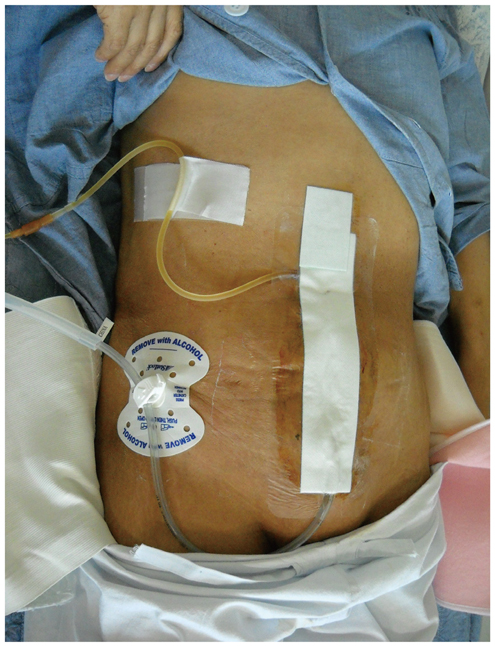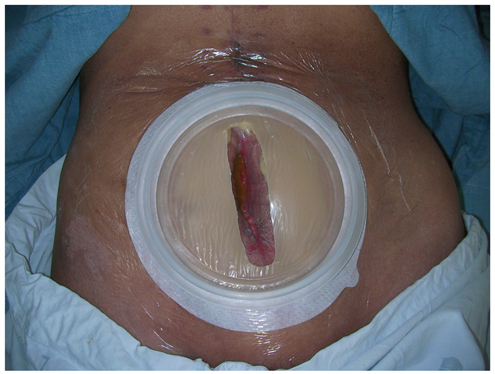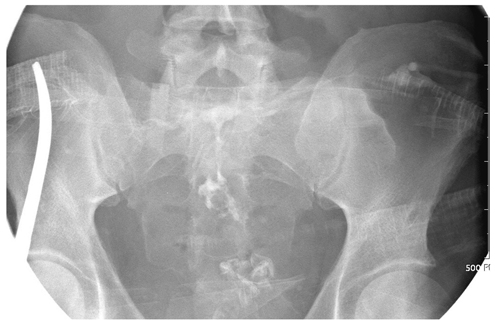Korean J Radiol.
2012 Feb;13(Suppl 1):S17-S20. 10.3348/kjr.2012.13.S1.S17.
Surgical Management of Enterocutaneous Fistula
- Affiliations
-
- 1Department of Surgery, Kyung Hee University Hospital at Gangdong, Kyung Hee University School of Medicine, Seoul 134-727, Korea. leeshdr@khu.ac.kr
- KMID: 1372863
- DOI: http://doi.org/10.3348/kjr.2012.13.S1.S17
Abstract
- Enterocutaneous (EC) fistula is an abnormal connection between the gastrointestinal (GI) tract and skin. The majority of EC fistulas result from surgery. About one third of fistulas close spontaneously with medical treatment and radiologic interventions. Surgical treatment should be reserved for use after sufficient time has passed from the previous laparotomy to allow lysis of the fibrous adhesion using full nutritional and medical treatment and until a complete understanding of the anatomy of the fistula has been achieved. The successful management of GI fistula requires a multi-disciplinary team approach including a gastroenterologist, interventional radiologist, enterostomal therapist, dietician, social worker and surgeons. With this coordinated approach, EC fistula can be controlled with acceptable morbidity and mortality.
MeSH Terms
Figure
Reference
-
1. Berry SM, Fischer JE. Classification and pathophysiology of enterocutaneous fistulas. Surg Clin North Am. 1996. 76:1009–1018.2. Draus JM Jr, Huss SA, Harty NJ, Cheadle WG, Larson GM. Enterocutaneous fistula: are treatments improving? Surgery. 2006. 140:570–576. discussion 576-578.3. Fischer PE, Fabian TC, Magnotti LJ, Schroeppel TJ, Bee TK, Maish GO 3rd, et al. A ten-year review of enterocutaneous fistulas after laparotomy for trauma. J Trauma. 2009. 67:924–928.4. Galie KL, Whitlow CB. Postoperative enterocutaneous fistula: when to reoperate and how to succeed. Clin Colon Rectal Surg. 2006. 19:237–246.5. Evenson AR, Fischer JE. Current management of enterocutaneous fistula. J Gastrointest Surg. 2006. 10:455–464.6. MacFadyen BV Jr, Dudrick SJ, Ruberg RL. Management of gastrointestinal fistulas with parenteral hyperalimentation. Surgery. 1973. 74:100–105.7. Rose D, Yarborough MF, Canizaro PC, Lowry SF. One hundred and fourteen fistulas of the gastrointestinal tract treated with total parenteral nutrition. Surg Gynecol Obstet. 1986. 163:345–350.8. Soeters PB, Ebeid AM, Fischer JE. Review of 404 patients with gastrointestinal fistulas. Impact of parenteral nutrition. Ann Surg. 1979. 190:189–202.9. Lévy E, Frileux P, Cugnenc PH, Honiger J, Ollivier JM, Parc R. High-output external fistulae of the small bowel: management with continuous enteral nutrition. Br J Surg. 1989. 76:676–679.10. Campos AC, Andrade DF, Campos GM, Matias JE, Coelho JC. A multivariate model to determine prognostic factors in gastrointestinal fistulas. J Am Coll Surg. 1999. 188:483–490.11. Edmunds LH Jr, Williams GM, Welch CE. External fistulas arising from the gastro-intestinal tract. Ann Surg. 1960. 152:445–471.12. Alvarez C, McFadden DW, Reber HA. Complicated enterocutaneous fistulas: failure of octreotide to improve healing. World J Surg. 2000. 24:533–537. discussion 538.13. Hernández-Aranda JC, Gallo-Chico B, Flores-Ramírez LA, Avalos-Huante R, Magos-Vázquez FJ, Ramírez-Barba EJ. [Treatment of enterocutaneous fistula with or without octreotide and parenteral nutrition]. Nutr Hosp. 1996. 11:226–229.14. Nubiola-Calonge P, Badía JM, Sancho J, Gil MJ, Segura M, Sitges-Serra A. Blind evaluation of the effect of octreotide (SMS 201-995), a somatostatin analogue, on small-bowel fistula output. Lancet. 1987. 2:672–674.15. Sancho JJ, di Costanzo J, Nubiola P, Larrad A, Beguiristain A, Roqueta F, et al. Randomized double-blind placebo-controlled trial of early octreotide in patients with postoperative enterocutaneous fistula. Br J Surg. 1995. 82:638–641.16. Datta V, Engledow A, Chan S, Forbes A, Cohen CR, Windsor A. The management of enterocutaneous fistula in a regional unit in the United kingdom: a prospective study. Dis Colon Rectum. 2010. 53:192–199.17. McNaughton V, Brown J, Hoeflok J, Martins L, McNaughton V, Nielsen EM, et al. Canadian Association for Enterostomal Therapy ECF Best Practice Recommendations Panel. Summary of best practice recommendations for management of enterocutaneous fistulae from the Canadian Association for Enterostomal Therapy ECF Best Practice Recommendations Panel. J Wound Ostomy Continence Nurs. 2010. 37:173–184.18. Avalos-González J, Portilla-deBuen E, Leal-Cortés CA, Orozco-Mosqueda A, Estrada-Aguilar Mdel C, Velázquez-Ramírez GA, et al. Reduction of the closure time of postoperative enterocutaneous fistulas with fibrin sealant. World J Gastroenterol. 2010. 16:2793–2800.19. Lynch AC, Delaney CP, Senagore AJ, Connor JT, Remzi FH, Fazio VW. Clinical outcome and factors predictive of recurrence after enterocutaneous fistula surgery. Ann Surg. 2004. 240:825–831.
- Full Text Links
- Actions
-
Cited
- CITED
-
- Close
- Share
- Similar articles
-
- Clinical analysis of enterocutaneous fistula
- A clinical review on post-operative enterocutaneous fistula
- Management of Enterocutaneous Fistula
- Laparoscopic Repair for Enterocutaneous Fistula Caused by Laparoscopic Right Hemicolectomy for Pan-Peritonitis due to Cecal Cancer Perforation
- Let’s Get That Bread Clip: Mechanical or Malignant Large Bowel Obstruction?




